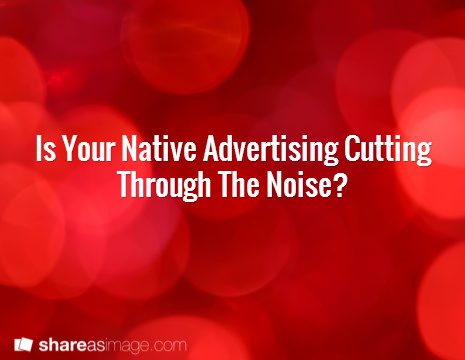
An increasingly dynamic and fragmented media environment has led to an explosion in the number of advertising messages a consumer sees, estimated at up to 5000 each day. In such a cut-throat grab for consumer-attention, marketers need to look beyond historically-standard avenues of connecting with audiences, i.e. conventional paid media. After all, you’re more likely to survive a plane crash than click on a banner ad.
We’ve seen an increasing number of web publishers develop “native” advertising products, featuring advertiser-funded content designed to blend in with the site. While the concept of content marketing has been around for decades, developments in the native advertising (or sponsored content) space have focused on standardization and formats.
For brands investing in native, there are several watch-outs to ensure your content is effective. These may seem obvious, but I’ve seen a number of examples in the market that overlook these principles.
1. Have a clear idea of your content objectives. These objectives should align with your overall communication objectives. Are you seeking to change perception of a brand? Raise awareness? Create chatter about a category? Awareness around the launch of a new product line or launch into a new market? Having a clear idea of content objectives should inform your content’s angle, tone and context.
2. Ensure content tone aligns with the publication. Think about your audience and the reason why they are on the publication. Are they looking to be informed, inspired or entertained? The New York Times recently developed a thought piece on women inmates in US prisons, coinciding with the release of the Netflix production “Orange Is The New Black.” The well-researched article clearly caters to the New York Times audience and contains opinion, statistics, interviews, visuals and thought-provoking emotion.
3. Be honest, how much value and engagement are you truly adding? In other words, if you were a consumer digesting this content, would you be moved enough to engage/share/comment? Ask yourself the following questions:
a. What value does this piece of content add to our consumer? If the answer is not clear within six seconds, perhaps native isn’t right this time.
b. How will our consumers relate to the content? Content should be entertaining or informative, and ideally visual and interactive.
c. Are we evoking emotion? Content that moves people becomes content that is shared. Use elements of awe, surprise, interest, comedy and amusement. Alternatively, create tension with anxiety, suspense or sadness.
4. Content needs to be relevant to your brand. While I’m personally a fan of Buzzfeed’s native platform, both positive and negative examples of content relevance can be found. A strong example of brand relevance for Fat Tire beer is a listicle called “10 Facts That Prove Beer Is The Most Fascinating Beverage In The World“. The piece incorporates the Fat Tire brand in an authentic way and supports the brand’s strategy of food pairing.
Recently Buzzfeed published “50 Thoughts We Had Watching The Fifty Shades Of Grey Trailer“. This was brought to you by Virgin Mobile. I’m sorry, but I can’t quite see the connection between an erotic romance film adaption and a mobile network operator.
5. Ensure that sponsored content is clearly indicated. Publishers historically have faced backlash from consumers who have felt they were duped into clicking a sponsored article. Native articles should clearly signal its intent. Remember the time you were tricked into spending 10 minutes of your day chatting to the charitable solicitors who you thought really did care about what you were up to that day? (Apologies to any charity solicitors reading this).
As more publishers and brands take up this form of marketing, we’ll continue to see both good and bad examples released. It’s up to us as marketers to ensure that the consumer-experience is at the center of all our communication activities. Native is no exception.